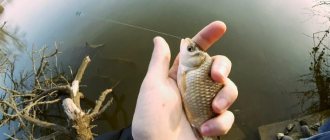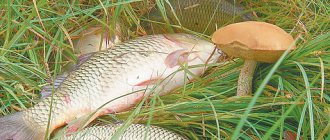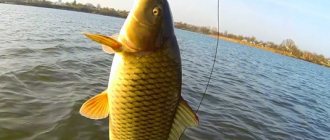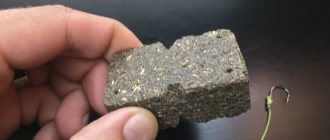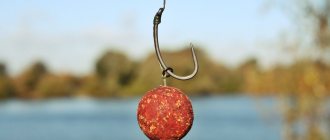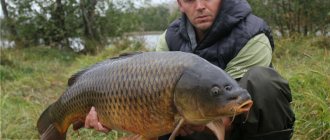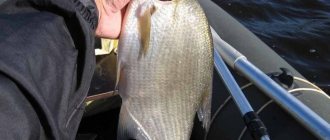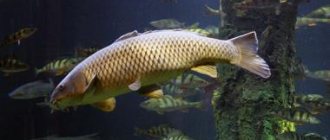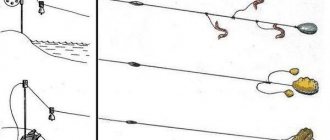Carp are often caught in ponds. On the paysite, everyone has the opportunity to compete with good fish . Many also find their carp in wild ponds and lakes. But fishing on the river is in many ways more interesting, and it can bring very good results. Flowing water bodies are inhabited mainly by carp, the wild cousin of carp. Catching it is especially interesting. The fish in the river are active, they bite resolutely, but when fishing they desperately resist.
How to catch carp on the river: features
The peculiarity of river fishing is that fish that live in running water are much stronger than pond water. Wild river carp is twice as strong as carp grown in pond farms. This happens both because the fish have to constantly fight the current and because it is much more difficult to find food in the river .
When fishing in flowing waters, you need to be prepared for powerful resistance. You will need strong tackle and careful fishing to cope with the fish. Reference! Another characteristic feature is that the bait is carried away by the current. When fishing on the river, it is important to choose the correct mixture composition and appropriate feeding tactics. There are also some nuances in choosing fishing spots on the river.
Features of fishing
Any bait is suitable for ring fishing. In addition, you can add hair rigs with boilies or corn. The simplest tackle, an ordinary feeder with a single hook and hair, canned corn, is the best tackle for catching carp with a ring. In addition, you can use peas or cake.
- Since the carp loves calm, we are under no circumstances nervous when fishing. In some fantastic way, he senses your nervousness and begins to beat harder. Measured, leisurely movements are the key to success.
- Before starting to control the landing net, the carp should be exhausted so that it gets tired - this will be indicated by the lateral position of the wild carp on the surface of the water. Many novice fishermen grab the landing net when they bite. If you do not exhaust the prey, it may jump out of the landing net at a crucial moment.
- We do not force events by using force. A strong fish can pull the hook out of its mouth. At this rate, you will be left without a catch and damage a valuable trophy.
- We fish carefully when the hook is weak, don’t behave aggressively, and don’t scare the fish. The hook should securely hook into the carp's mouth.
The strength of the carp is comparable to the Astrakhan catfish or large carp. Since this fish does not give up right away, get ready for long and patient fishing, with repeated breaks in the gear. However, it all goes to show how exciting ring fishing for carp from a boat can be.
TAGS:
Choosing a fishing spot
To look for carp and carp on the river you need to:
- under cliffs, under high washed-out banks;
- on bends;
- in bays and creeks.
These are typical catching places for fishing on rivers . Carp can also be found at typical points that attract it in any body of water:
- on edges and pits;
- on shell rocks - areas where the bottom is strewn with dracena;
- at the confluence of tributaries - streams and small rivers;
- at the boundaries of vegetation thickets;
- near fallen trees and snags.
Snags are the most promising fishing spots. You can always find fish here. But, since fishing in strong cramps is impossible due to frequent snags, gear is thrown to the boundaries of such areas.
Carp avoids areas with fast currents. Of course, this strong fish can easily overcome the resistance of any water flow. But in areas with fast currents, it does not feed, since food does not linger here. Therefore, you need to catch carp where the water flow slows down.
Fishing tackle
For successful fishing, the tackle for catching the top should be prepared in advance, although its simplicity allows you to do all the operations directly while fishing. There are a great variety of gear types, so it is proposed to consider the most common option.
For production you will need:
- Sinkers . There may be several of them for different fishing conditions, they exist in different shapes, but the most common are the “dovetail” type sinkers. Sinker weight for standing water: 60-80 grams, and for current: 80-180 grams.
- A piece of fishing line or cord . The fishing line should be 0.35-0.4 mm, and the cord 0.2-0.3 mm.
- Hooks with a short shank . Their size is chosen depending on the size of the expected production. Usually this is Nos. 4-6.
- Cord for leashes . The use of fishing line is not advisable, as its rigidity may alert the fish. A diameter of 0.15-0.20 mm is quite enough.
- Special fastener for the crown . It can be easily purchased in fishing stores. It's better to have some supply of them. Structurally, it is a wire loop, on the wide end of which there is a ring for attaching leashes, and on the narrow side there is a spring latch for attaching to the fishing line.
For production you need:
- A 25-30 cm piece of fishing line or cord should be passed through the hole in the sinker in the direction from the narrow to the wide side, and then tie two figure-of-eight knots one above the other at a distance of 20-25 mm from the end of the fishing line. The line should thicken. At the other end, a regular loop is knitted for attaching to the fastener of the main fishing line.
- On a piece of cord for leashes 20-25 cm long, two hooks are tied, and then the leash is folded in half and attached with a simple loop to the fastener ring.
- A hole with a diameter of 3.5-4 mm is drilled in the center of the top block , through which a fishing line is passed through the load. A knot is inserted into the narrow end of the fastener, snapped there, and then the fastener is inserted into the hole in the top of the head.
- The line is pulled up as a result of the crown falling on the load. If the hooks are attached to the top of the head, then it is better to drill 1-1.5 mm holes in the corners, 1 cm deep. Then the tips of the hooks will not become dull when they are stuck into the dense top of the head.
The tackle is ready! To deliver bait to the required distance, they usually use either special carp or spinning rods with the appropriate test and equipped with spinning reels of size 3000-5000. Better with rear clutch.
How to catch carp on the river: gear
Bottom fishing rods
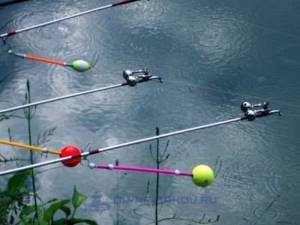
The advantage of donks is that it is more convenient to fish with them in the current.
After casting, the equipment falls to the bottom and, if the sinker or feeder is selected correctly, remains at one point. After this, you can calmly wait for a bite, making recasts every 15-20 minutes or less. To catch carp on the river, all types of donks are used, but some of them are better suited for such fishing, while others are worse.
- Zakidushka is the simplest version of a donkey, consisting of a reel on which a fishing line with a sinker and one or more leashes with hooks are wound . To fight such strong fish as carp, it is better to use a rod with guides and a reel instead of a reel. It will be very useful when fishing for trophies.
- An elastic band - the advantage of this type of donkey is that when fishing with it, you can put the equipment on the bottom at the same point over and over again , without the need to make casts , the sound of which often scares away the fish. The equipment consists of: a load weighing 1-3 kg, a piece of braid tied to it, to which an elastic band up to 15 m long is tied, a working section of fishing line with leads and the main fishing line.
- Makushatnik is one of the best folk (not sports) gear for catching carp on the river. To assemble the equipment of this donkey, at the end of the main fishing line you need to attach a sinker of a special design and 2-3 leashes with hooks. You can buy a special weight for fishing with a fly rod at a fishing store. Before casting, you need to attach a piece of flour (cake) to it and stick hooks into it. The carp, which has approached the smell of the treat, will begin to feast on it and pull the hook into its mouth.
- The feeder is a donk, the equipment of which necessarily includes a feeder. When fishing with it, you can always be sure that the bait is located directly next to the nozzle , which means that the probability of a bite is maximum. In the classic version, there is only one leash with a hook at the end.
- Carp tackle is a bottom fishing rod that is designed only for catching carp and carp and is best suited for hunting large fish. Very similar to a feeder, but differs from it in greater power. Unlike feeder gear, the equipment of a carp fishing rod often does not include a feeder; instead, a sinker is mounted on the fishing line.
Float rods
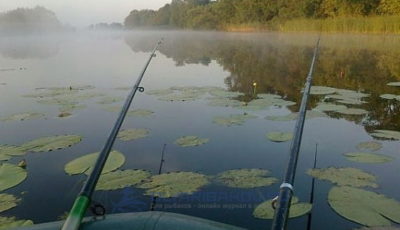
But it is much worse suited for catching trophy fish than donka , since it lacks power.
Even the strongest float rods can hardly withstand the fight with 10-12 kg fish , which use the current to get away from the angler. If a more respectable specimen is hooked or the fishing takes place next to a snag where the carp can put the equipment and entangle it there, the chances of pulling it out with a float rod are very low.
For carp fishing you can use:
- fly rod - for catching small fish in the coastal zone ;
- Bolognese tackle - this is a float fishing rod for fishing with a wire , with which you can also make long casts;
- a match fishing rod is a tackle for long-distance ; it is also suitable for wire fishing, but not as good as a lapdog.
The best choice for catching carp and carp in the river would be powerful float rods with large casts, equipped with spinning reels. With them you can either make long casts, at a distance of up to several tens of meters, or simply release the equipment downstream near the shore.
Preference should be given to short, up to 4 m, fishing rods. Such a compact tackle weighs little, so it is comfortable to fish throughout the day. It is better to use small reels for float fishing, up to 3000 in size. Larger models, again, make the tackle heavier.
How to choose gear for carp
Lures
The best time to catch carp is the season when the water temperature fluctuates between 18-260C. When choosing bait, they proceed from traditional principles - wild carp are caught using familiar food items: cephalopod meat, worms, fish or crayfish meat. But in many regions, fishermen fish with porridge and other mixtures that are hardly available to “savages” in everyday life. Fishing stores have various baits in stock in the form of ready-made canned baits, but it is always worth checking the taste preferences of the fish with experts or owners of the reservoir. The following rule is most often applied to baits and flavors: for cold water - animal baits and weak odors; The warmer the water, the more often the use of plant baits and sweet aromas. For all equipment it is possible to use a large number of different granules or “pellets”. Boilies can be divided into groundbait and bait boilies. Their cost and packaging size depend on this. The size is selected based on the intended trophy and its dietary preferences. As a rule, a large boilie size “cuts off” bites from small fish. In general, it is almost impossible to describe the number of products used for catching carp. It is better to take the opinion of local fishermen and fishing guides.
Feeding
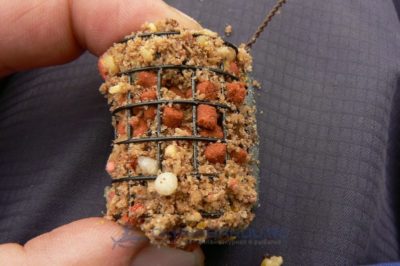
You can lower it into the water separately when fishing both with a float rod and with a casting donk.
Another option is to feed with the bait that is used as bait . You can throw corn, peas, pearl barley or boilies into the water in bulk.
The advantage of this method is that such bait does not produce turbidity, which often scares away the carp, while attracting small things . This feeding method is well suited for fishing near the shore at shallow depths. The current will carry away the grains, so you need to regularly add new portions of food into the water.
The next method of feeding is to use multi-component mixtures , which must be filled with water. After this, they can either be thrown into the water with balls, or hammered into a feeder feeder. This feeding method is well suited for any conditions, including fishing at great depths.
Important! The main thing in this case is to choose the optimal consistency of the bait, that is, to understand how much water to pour into it. The mixture for fishing in currents should be more viscous and sticky than for fishing in still water.
The correct concentration for fishing in a particular place determined experimentally. If, when fishing with a bottom with a feeder, the food is washed out of it too quickly after casting, then you need to add more water. When its quantity is optimal, the food will be gradually washed out of it after the equipment falls to the bottom, attracting the carp to the hook with the nozzle.
During the current you need to use a lot of bait , much more than when fishing in still water, since the mixture is quickly carried away by the flow of water. Experienced carp fishermen often throw several tens of kilograms of feed mixture into the water during a couple of days of fishing. And this allows them to achieve excellent results, catching a lot of trophy fish.
Bait for carp and carpHow to prepare bait for carp with your own hands
What to use to catch carp and carp
Both carp and carp are omnivorous fish. Therefore, they are caught using a variety of baits. In spring and autumn, they prefer animal food rich in protein, so fishermen mainly hook worms, bloodworms, maggots, burdock moth larvae, grasshoppers, crayfish meat, various insects, boilies of appropriate flavors, etc. On summer days, when the water is well warmed up, carp or carp prefer vegetable baits, including:
- bread;
- dough;
- pearl barley;
- peas;
- corn;
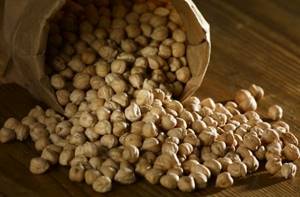
Carp and carp bite well on chickpeas
- pellets;
- boiled potatoes;
- cake balls;
- chickpeas and more etc.
Of course, fishing for carp and carp should be accompanied by feeding. To do this, you can use ready-made dry mixtures, which are mixed in a pond by adding local water, or bait prepared independently. It can contain various ingredients, but, as a rule, the base is all kinds of cereals and cereals, potatoes, cake, flour products and many others. etc.
Attractants and flavorings play a significant role when fishing for any carp.

For a better bite, you should feed the fish
It can be:
- Dyes or visual attractants. Sold in both liquid and powder form. They serve to make the bait brighter and more noticeable. Or, on the contrary, they help darken the bait, giving it the color of the bottom. After all, carp or carp may be frightened by an incomprehensible colored spot and not approach the baits.
- Chemical carriers of odors. They are glycerin or alcohol based. Most often they are sold in liquid form in small containers. Sometimes they are also used as sprays for treating baits before casting. The flavor palette is almost unlimited: from the usual and familiar smells of garlic, mint and honey to “exclusive” and unusual aromas - mulberry, red krill, sweet spices, etc.
- Deeps. These are special flavors designed to impregnate bait and groundbait. They come in liquid, powder and even gel form. Dips can enhance the flavor of the bait or change it completely. Some are also able to give them a different color.
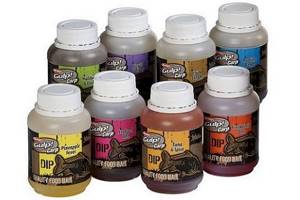
To make the bait more attractive, dips are used
- Essential oils. Also quite productive attractants when fishing for carp. They dissolve well in water and are able to lure fish from both short and long distances. Most often, carp anglers use eucalyptus, geranium, juniper, clove and garlic oils.
Selection of nozzles
For catching carp on the river, the following are best suited:
- corn;
- steamed peas;
- pearl barley.
It is these affordable attachments, which are very easy to get , that you should definitely add to your arsenal. In general, river carp, unlike its pond brother carp, is not very picky. In summer, he usually willingly takes any bait offered to him. The main thing is to find a suitable place , and what nozzle to use is not so important.
Reference! In spring and autumn, when the water is colder and the carp is passive, it is more difficult to force it to bite. At this time, it is worth trying animal baits such as bunch of worms or shell meat. Boilies are a good choice for catching trophy fish in the river at any time of the year.
Catching carp
You should adhere to an ironclad rule : fishing for carp on top should always be accompanied by feeding both before casting and during fishing. This can be done with a regular mash, but always with the addition of dust, which remained as waste during cutting.
The made bait is thrown into the feeding area, then the rod is placed on a special stand that fixes it. An alarm or a regular bell is installed on the fishing line . The reel is put on the brake, but the clutch should not be too tight so that the carp does not drag the rod into the pond.
Once in the pond, the dust begins to gradually erode, spreading a strong smell around. The fish comes to the smell and begins to suck in the bait along with hooks on soft leashes. At the moment when the carp begins to try the top , there is no need to hook it. This is clearly visible from the smooth movements of the bell or alarm, but as soon as the carp wants to move to the side, the movements become obvious and sharp. At this very moment it must be hooked and fished out.
Carp are strong fish, so when fishing you need to skillfully maneuver the rod and drag to tire it out and be sure to use a landing net. If there are no bites, after 1.5-2 hours the top of the tackle is replaced, not forgetting to feed the place.
We also invite you to watch a video on catching carp on the fly .
Are you interested in catching pike perch on the track? Read more about this in our article.
This article will teach you how to catch pike with a frog.
Features of fishing techniques
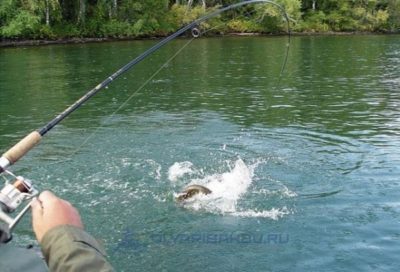
If you fish with a donk, it is important to select the optimal weight of the load or feeder for each of the points . After falling to the bottom, the equipment should not be dragged by the current. In some cases, 30-40 gram weights or feeders are enough, in others you need to use 100-120 gram weights.
Carp bite in the river more decisively than in standing reservoirs . Therefore, its bite is not difficult to notice. The lips of river carp are much stronger than those of pond carp, since mollusks with hard shells occupy an important place in the diet of wild fish. Accordingly, the probability of self-hooking when catching it is less, and you need to hook it more sharply after the bite.
When fishing, you should always be prepared for the fish to go downstream. This can happen completely unexpectedly. When the flow of water helps the carp, its resistance increases greatly. In this case, you may need to move the rod after the fish and follow it along the shore, and loosen the clutch so that the trophy that lands on the hook does not break the equipment.
Carp and crucian carp
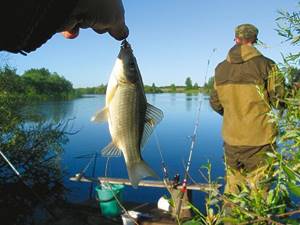
Photo by the author
Carp... There is probably no fisherman who would not strive to catch this strong and beautiful fish. Usually the Volga delta, consisting of many eriks and channels, is rightfully considered the most catchy and carp place. This is where large carp live, and there are simply a lot of small carp here. But carp are found not only in the lower reaches of the Volga. This fish is often found in small rivers and even ponds, although trophy-sized carp are rare here.
The first condition for successful fishing is relative desertion on the shore, which means that the place should be inconvenient for catching other fish such as silver bream, roach, bream and Volga predators. And these are quite deep holes and slopes on them, especially if there is some kind of shelter at the bottom in the form of driftwood or stones. It is on the edge rays that wild carp hang on. The depth of the main pit can reach more than ten meters. This is exactly the place that is worth checking for the population of carp. The presence of shallow water areas nearby, where there are a lot of small carp, is also a positive factor. This means that large fish can also stay nearby. Sometimes a signal that a wild carp lives in a given area of a reservoir is the so-called “fight” of a carp, when the fish jumps out of the water upright.
It’s good if, in addition, the shores are uncomfortable in terms of conditions for a resort holiday. That is, uneven and filled with some kind of loose soil, where ants and other insects swarm, instead of the clean sand on which vacationers love to frolic.
How to catch him?
Catching carp is impossible without luring it to the bait. In addition to the correct choice of place, bait plays a decisive role in catching trophy carp, and this is not short-term bait for a given day, but feeding the fishing point for 3-4 days. Having found a place suitable for fishing, you should mark it with something. This can be any foam buoy or even an empty plastic bottle. If there are no large stones on the shore for an improvised anchor, then you can fill a tarpaulin or even thick polyethylene bag with sand or pebbles, and then anchor the buoy at the bottom using a cord or strong fishing line. There will be a place for catching trophy carp. Usually the place for bait is chosen upstream of the river, at least 15-20 meters from the fishing point, since the current is strong and the bait will be thrown down.
The bait used is the one that will be placed on the hook of a carp donka with the addition of river clay and flavorings, most often fruit in the summer. Fishing with boilies is usually practiced, since this bait is large and inaccessible to small fish. These are balls made from various components, where the base can be corn, wheat and other ground cereals, aromatics, proteins, gelatin and, of course, chicken or quail eggs. These balls are boiled until they begin to float in boiling water. In the summer, fruit boilies with spices are often used, often exotic in our understanding, for example, orange citrus or red pepper. Closer to autumn, more high-calorie components of boilies are required, where fishmeal and even fish oil are used as additives. And this is understandable, because the carp also needs to gain fat for the cold season.
At least 10 kg of boilies and boiled corn are used per day for bait, and given that baiting for successful fishing can last about 3-4 days, then about 40 kg of bait will be needed. But this is a prerequisite for achieving the goal - catching trophy fish. Boilies for bait are cut into halves so that they do not roll along the bottom. But the bait is not just poured into the water, but first rolled into large heavy balls along with viscous river clay. The bait is brought in by boat and lowered to the bottom without unnecessary impacts on the surface of the water, so that they do not crumble.
To catch large carp, strong carp rods with powerful reels are used, designed to catch fish weighing up to 20 kg. The strongest braid is also required, and the hooks bear the greatest responsibility. These should be carp hooks made of good thick wire No. 2-4, according to the international classification. The drag must be pre-set for strong, large fish. In addition to a large amount of bait, you will also need supplies of sinkers, since in carp fishing the sinkers come unfastened and fall to the bottom, making it easier to land large fish. This is achieved by special fastening of the sinker using a clip, which opens during strong pushes of the carp.
The equipment can be boilie, an example is carp fishing, where the boilie is pierced with a needle with a notched tip, and then the leash is passed into the boilie and the nozzle is secured to the fishing hook. They also use equipment based on the principle of a cake bottom, where a slab of cake, like a boilie, is pierced in the center and then secured on a braided cord above a hook with grains of boiled corn impaled on it using hair. Here the cake serves rather as bait. And the fish sits on a hook with corn. This is among athletes who promote the catch-and-release principle. Among fishing fishermen, where the cake slab is wrapped in leashes with hooks, the fish swallows the bait, because it then goes to food, and is not released back into the river.
Crucian carp on the feeder
Fishing for crucian carp is included in the list of the most popular fishing trips, both among floaters and among fans of feeder gear. Despite the fact that crucian carp is considered a sluggish fish and does not like fast water, nevertheless, modern crucian carp has noticeably tightened up, become more driven and able to hold on even in the current along with its relatives from the carp family - roach, ide, bream. At the same time, its exits do not necessarily occur in river bays, at the exits of oxbow lakes and other relatively quiet places. Often powerful crucian carp bites on the feeder happen on the stream itself, where, it would seem, one could only wait for a fast-moving ide or a red-eyed roach.
Fishing begins with stirring bait, which uses ready-made mixtures. They are not cheap, but effective, designed for large fish, no matter whether it is crucian carp or bream. But a simple fisherman does not always have such an opportunity to buy sports feeder mixtures. And, as usual, he begins to create. Moreover, the results of creativity are often not inferior to the results of the work of fashionable companies producing bait mixtures. It bites the same way. And often homemade bait works even better.
Homemade feeder baits are quite simple, but fragrant. The composition may be different, but in general, ground or ready-made breadcrumbs are used as the basis; corn flour, dry semolina, ground Hercules, finely ground, slightly fried seeds are also added, if there is no cake. Ground gingerbread and cookies give a sweet biscuit taste. The fillings are also simple. You can take with you when fishing ready-made porridge made from undercooked millet cereal, as well as boiled peas, preferably soft and crumbly, similar in density to pea puree. All this, of course, can be cooked right on the shore, if you have time and a suitable vessel.
You can add liquid dip or syrup from a series of different dips for crucian carp from fruit to garlic to the finished bait. Anise probably won’t be very to the taste of crucian carp, but you need to check. Each body of water and each of its inhabitants have different tastes. It also doesn’t hurt to add a packet of cooking vanilla sugar to the bait. It certainly won't do any harm.
After the feeder bait begins to swell from the added water, you can start punching the bottom with a marker weight at the site of the upcoming fishing. This not at all superfluous operation will allow you to find the edge-difference from the shallow coastal part of the river to the channel pit, which, if we talk about small rivers, is located closer to the opposite bank. This is the case if you are with gear on a sandy, sloping beach or low clayey shore. Usually, opposite such a spit, the bank on the opposite side is steep and high.
Having thrown the marker weight to a point closer to the opposite shore, you should count the speed of its fall to the bottom, which is done by the simplest mental counting by “times”. You already know in advance how long it takes for the weight to fall to a certain depth. It remains to determine this in relation to this place.
Having calculated the depth at the place where the weight falls, you should check the bottom for clutter, the presence of shell rocks and grass, and also find the very edge that is likely to become catchy that day. This is achieved by pulling the weight to the shore, where the creaking of shells and the resistance of the rising bottom will let you know - this is the place. All that remains is to fix the line on the reel in a Teflon-coated clip and prepare the place for fishing. This is achieved by repeatedly casting a filled feeder to the fishing point, which will create a spot of bait on the bottom. After this, you can fill the feeder with bait and bait the hook with dung worms with the addition of a couple of maggot larvae. This will be a “sandwich” that no crucian carp can resist, if only it lives in this place... Fishing for crucian carp on a feeder can be fun and productive, especially in the cold autumn times, when the fish move far from the shores.
Alexander Tokarev November 2, 2015 at 04:21
Catching Carp with an Elastic Band | Advantage of Tooling
No less popular is the Carp Tackle - Elastic Band. This is a very simple tackle.
Its big advantage is that you don’t have to cast the tackle every time. The elastic band consists of several parts. At the beginning there is a large load, at least 1000 g. This load will lie at the bottom of the reservoir.
A special fishing elastic band with a length of 2 to 20 m extends from the load. The elastic band will serve as a shock absorber, thereby delivering the hooks to the fishing spot.
A piece of fishing line from 2 to 10 m is tied to the elastic band, where hooks will be attached every 10 to 15 centimeters.
The gear is either thrown from the shore or brought in by boat. It's worth noting that a fishing rod is not required.
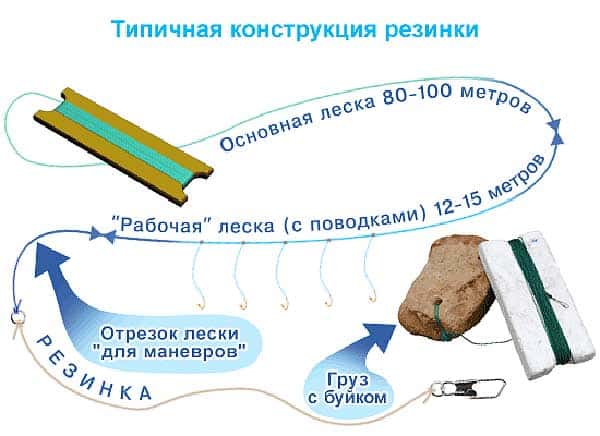
3 ways to improve your fish bite!
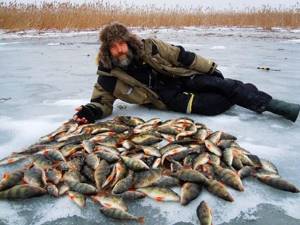
Over 15 years of active fishing, I have found many ways to improve the bite, and here are the most effective:
1. Bite activator . This pheromone additive attracts fish most strongly in cold and warm water. The Fish Hungry bite activator has proven itself to be excellent - Read more…
2. Tackle with increased sensitivity . You should first familiarize yourself with the features of using a particular type.
3. Pheromone baits . They attract the attention of fish, stimulate hunger and cause a schooling reflex, which allows you to collect a lot of fish in one place.
You can get the rest of the secrets of successful fishing for free by reading my other materials on the site.
3 ways to improve your fish bite!
Over 15 years of active fishing, I have found many ways to improve the bite, and here are the most effective:
1. Bite activator . This pheromone additive attracts fish most strongly in cold and warm water. The Fish Hungry bite activator has proven itself to be excellent - Read more…
2. Tackle with increased sensitivity . You should first familiarize yourself with the features of using a particular type.
3. Pheromone baits . They attract the attention of fish, stimulate hunger and cause a schooling reflex, which allows you to collect a lot of fish in one place.
You can get the rest of the secrets of successful fishing for free by reading my other materials on the site.
Donka
Bottom rigs for carp are used when fishing more often than float rigs. This is due to the fact that the bottom allows you to cast the bait far, put a strong main line that prevents breakage when fishing for large specimens, accurately feed the fishing spot, etc.
Fishermen use three types of bottom gear:
- feeder,
- carp equipment,
- homemade products - makushatnik, “spring”.
Let us consider in detail the properties of each position from the list.
Feeder
This tackle for carp combines two important properties - long casting (up to 100 meters) and delivery of bait to the fishing point. At the bottom, after several preliminary casts, a feeding table is created, onto which, if the components are successfully selected, the carp fits. The bait with the hook is nearby.
Tackle components:
- Feeder rod for carp with a length of 3.3-3.9 meters, fast action and a test load of 60 grams. The test for the carp feeder is selected both according to sensitivity and the ability to withstand the jerks of this strong fish. That is, a reasonable compromise is needed. Self-cutting equipment is rarely installed on the feeder, so constant attention to the condition of the tip is required.
- The reel is inertia-free with an index of 3500 to 4000, preferably with a baitrunner system. A conventional reel with a friction spool, equipped with a button to block reverse rotation and control the clamp, also shows good results.
- The main monofilament line will be needed with a diameter of 0.23-0.25 millimeters and a length of up to 200 meters. It is recommended to install it with a shock leader up to 10 meters long, which can prevent the gear from breaking during casting. If braid is used (it does not stretch and allows you to register bites at a great distance) - then up to 0.15 mm.
- For standing water, the weight of feeders usually does not exceed 60 grams. During currents, it is recommended to use a container of greater weight with a rectangular cross-section so that it does not move along the bottom. Good results are obtained with a “method” style feeder, which even allows the use of hair rigs and the principle of self-cutting.
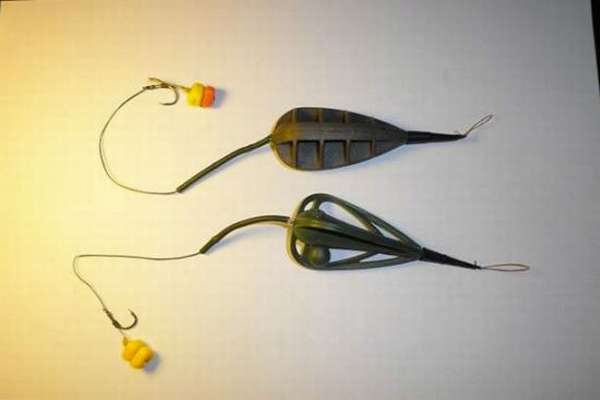
Equipment with a “method” feeder and hair equipment providing for self-cutting
The feeder for catching carp is secured in any convenient way - paternoster, symmetrical, asymmetrical loop or sliding method - for the “method” and ordinary containers.
The advantages of feeder fishing for carp: good selectivity, which allows you to cut off unwanted fish species using bait, and which is achieved by carefully selecting the components of the mixture. Possibility of catching carp in the current.
Disadvantages: constant monitoring of the tip is required; when catching large specimens, the feeder rod does not allow forced landing of carp and carp - the tackle is “delicate” for large carp.
Carp equipment
The gear for carp and carp is similar, so you can use proven options. On a special carp bottom, the carp is hooked without the help of a fisherman. It is equipped in such a way that, instead of a feeder, a sinker weighing 60 grams or more is fixed at this place (or below), silently or with a very small stroke; the bait (boilie, corn, etc.) is not put on the hook itself, but is attached to it using hair equipment. Having taken the bait, the fish begins to move, and the hook unfolds and sticks into the lip of the carp under the influence of the load.
You need fishing rods - carp or spinning rods with a large cast. Reels – from 5000 with a capacity of 200 meters of monofilament with a diameter of 0.25 mm or more. Bite alarms are either special electronic devices built into rod stands, bells or any other guard. The choice depends on the time of day and the capabilities of the fisherman.
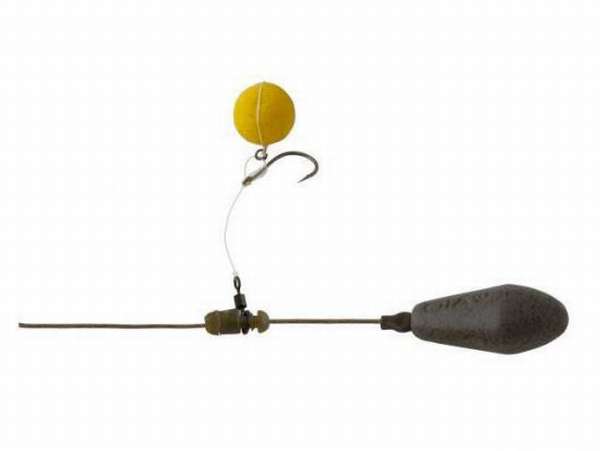
Carp rig – solid fastening of the sinker and tight movement of the leash along the main line
Pros: reliable hooking and the ability to fish with several rods.
Cons: both carp and cupid can take the bait.

